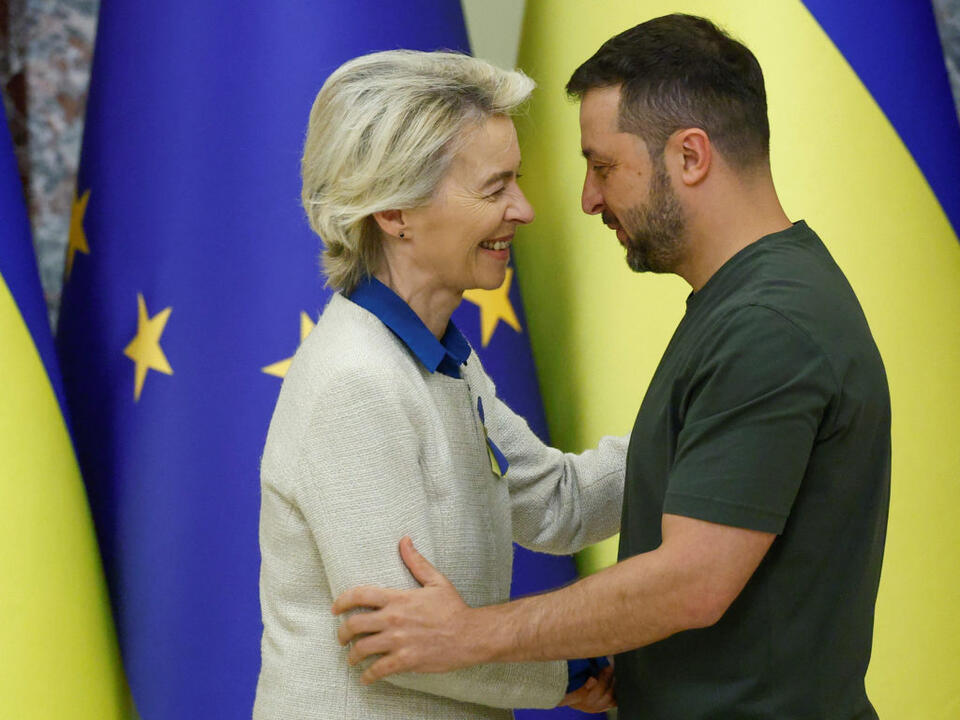Physical Address
304 North Cardinal St.
Dorchester Center, MA 02124
Physical Address
304 North Cardinal St.
Dorchester Center, MA 02124

KYIV, Ukraine – The European Union has committed to providing Ukraine with up to 35 billion euros (approximately $39 billion). This comes as part of a loan package coordinated by the Group of Seven (G7) industrial nations, aimed at aiding the country in its recovery efforts and the rebuilding of its war-torn power grid.
In June, G7 leaders had reached a consensus to arrange a substantial $50 billion loan to support Ukraine in its ongoing struggle for survival. Interest accrued from the profits of Russia’s frozen central bank assets is designed to serve as collateral for these loans. However, there have been notable delays in distributing this vital financial assistance.
During a news conference in Kyiv with President Volodymyr Zelenskyy, European Commission President Ursula von der Leyen emphasized the necessity of making Russia accountable for the damage it has inflicted. She stated, “We should make Russia pay for the destruction it caused.”
Since the outset of the war in February 2022, the EU has delivered over 118 billion euros (around $132 billion) in various forms of military and economic aid to Ukraine. Von der Leyen indicated that, despite this support, the aggressive assaults from Russia necessitate further assistance.
Von der Leyen outlined the benefits of the new loan, asserting, “Crucially, this loan will flow straight into your national budget. This will improve Ukraine’s macro-financial stability and provide you with significant and much-needed fiscal space. You will decide how best to use the funds, giving you maximum flexibility to meet your needs.”
The funding for these loans is secured through profits generated from nearly $300 billion in Russian assets that have been frozen since the start of the invasion. Most of these assets are held in EU countries, particularly Belgium.
She expressed confidence in the EU’s capability to deliver this loan to Ukraine promptly. The bloc of 27 nations hopes that additional G7 countries will also take steps to provide financial support.
Zelenskyy stressed the priorities for Ukraine’s rebuilding efforts, specifically mentioning the restoration of the energy network, the construction of more bomb shelters, enhancement of educational facilities, and the procurement of additional weapons and ammunition.
Von der Leyen visited Ukraine with a focus on assisting in the restoration of the electricity grid and increasing the country’s heating capacity as winter approaches. Approximately half of Ukraine’s energy infrastructure has been devastated during the ongoing conflict, leading to rolling blackouts in some eastern regions for up to four hours at a time. Von der Leyen likened the situation to all of Latvia, Lithuania, and Estonia losing power simultaneously.
As winter looms, the urgency is palpable. “Heating season starts in two weeks, and Russia’s relentless attacks on Ukraine’s civilian energy infrastructure aim to inflict maximum damage,” von der Leyen remarked. “We will help Ukraine in its brave efforts to overcome this.”
The main objective is to enable Ukraine to decentralize its power grid, reducing reliance on large power facilities that are easier targets for Russian strikes. Recently, a significant missile assault targeted energy infrastructure with around 260 missiles.
The EU has already provided more than 10,000 generators and transformers, in addition to supplying smaller, more portable gas turbines, which are more challenging to target and easier to repair.
Ukraine faces a winter that typically extends from late October to March, with January and February often being the most severe months. The EU aspires to help ensure around 25% of the 17 gigawatts of energy that Ukraine is projected to need this winter.
One of the aims behind the EU assistance is to encourage individuals to remain in Ukraine. Since the war began, around 4 million people have fled, primarily to neighboring countries like Poland. The EU has provided support such as short-term aid for accommodation, employment, or education. However, there has been an uptick in the number of people seeking to leave Ukraine, with the European Commission estimating around 10,000 new requests for assistance each week.
If this trend continues, it could pose challenges for maintaining European support for Ukraine. Recently, the European Commission announced an additional allocation of 160 million euros (about $180 million) aimed at reinforcing the country’s energy network, with 100 million euros derived from the profits made from frozen Russian assets. Denmark is actively participating in deploying these funds to acquire weapons and military equipment through Ukraine’s defense industry.
Source: AP



